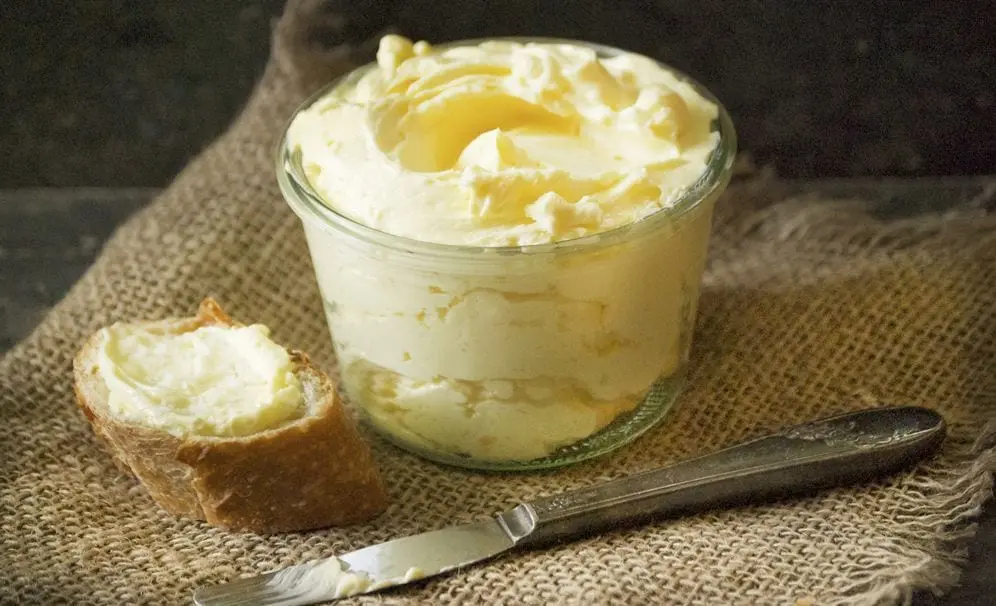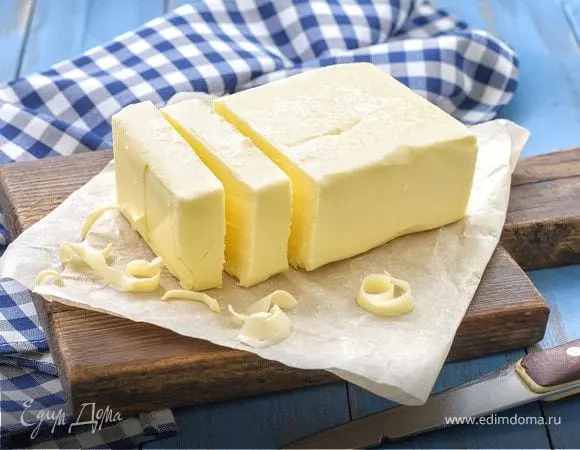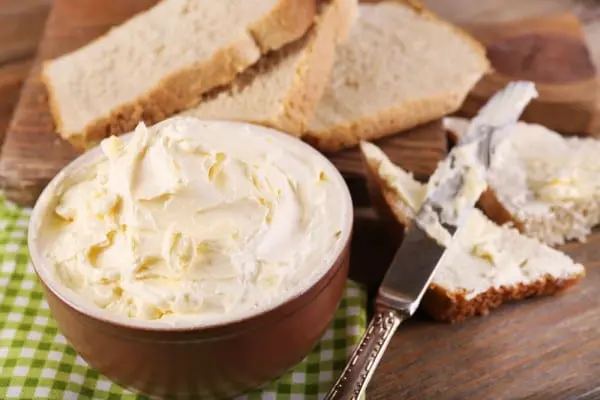Contents
- Description
- Kinds
- Calorie content and composition
- Using
- The benefits of butter
- How to choose butter
- Butter: good or bad?
- Butter and excess weight
- How to replace butter and whether you need to do it
- And finally, can butter in reasonable amounts be dangerous?
- And here the opinion of official science is quite unambiguous:
- Butter at home
Description
Butter is a dairy product obtained by whipping or separating cream from cow’s milk. Differs in delicate creamy taste, delicate aroma and color from vanilla to light yellow.
The solidification temperature is 15-24 degrees, the melting temperature is 32-35 degrees.
Kinds
Depending on the type of cream from which the butter is made, it is divided into sweet cream and sour cream. The first is made from fresh pasteurized cream, the second – from pasteurized cream, which was previously fermented with lactic acid bacteria.
Before churning butter, the cream is pasteurized at a temperature of 85-90 degrees. Another type of butter stands out, which is made from cream heated during pasteurization to 97-98 degrees.
There are such types of butter depending on the fat content:
- traditional (82.5%)
- amateur (80.0%)
- peasant (72.5%)
- sandwich (61.0%)
- tea (50.0%).
Calorie content and composition
100 grams of the product contains 748 kcal.

Butter is made from animal fat and therefore contains cholesterol.
In addition, it contains vitamins A, D, E, iron, copper, calcium, phosphorus, sodium, zinc, manganese, potassium, tocopherols.
- Proteins 0.80 g
- Fat 50 – 82.5 g
- Carbohydrates 1.27 g
Using
Butter is used for making sandwiches, creams, dressing for cereals, soups, added to dough, fish, meat, pasta, potato dishes, vegetable dishes, pancakes and pancakes are greased with it.
It can also be used for frying, while the taste of the dish will be delicate, creamy. However, when exposed to high temperatures, the butter loses its beneficial properties.
The benefits of butter
Butter log for gastrointestinal diseases. Vitamin A heals minor lesions in the stomach.
- The oleic acid in the butter helps reduce the risk of cancer.
- Fatty foods are a great source of energy, so butter is good for people in harsh climates, as it helps keep you warm.
- Fats that make up the cells of the body, in particular, those found in the tissues of the brain, actively promote cell renewal.
- By the way, butter can be heated without fear of health. For frying, it is better to use ghee.
How to choose butter

The butter should have a homogeneous structure, creamy, delicate taste, without unnecessary impurities, and have a mild milky smell. Its color should be uniform, without specks, dull, from white-yellow to yellow.
Butter: good or bad?
Demonization of certain foods is an eternal trend in dietetics. At various times, experts have called for excluding red meat, salt, sugar, eggs, animal fats from the diet.
Citing irrefutable, at first glance, arguments and referring to the studies of reputable scientists, doctors rid the patients’ refrigerators of their favorite food, which threatened to increase cholesterol levels, cancer, and also overweight.
Butter also came under criticism. It was declared almost the main cause of the epidemic of obesity and diseases of the cardiovascular system. NV Zdorov’e figured out what is true and what is myth.
Butter and excess weight
The best prevention of obesity for a healthy person is adherence to the daily caloric intake. Calorie intake should not exceed consumption – this is the point of view of official medicine.
And here lies the main danger of butter – it is a high-calorie product. Depending on the fat content, it can range from 662 kcal to 748 kcal per 100 g. But this does not mean that the product should be excluded from the diet – you just need to control its consumption.
How to replace butter and whether you need to do it

Some nutritionists suggest replacing butter with vegetable fats. However, does it make sense? From the point of view of preventing obesity – no, because vegetable fat also has a high energy value. For comparison, flaxseed butter, olive oil, and avocado oil, recommended by many healthy lifestyle advocates, contain as much as 884 kcal / 100 g.
Another thing is that the nutritional composition of the consumed products is also important for a healthy diet. Butter is mostly saturated fat, as is the popular coconut and much criticized palm oil.
Most other vegetable oils are composed of unsaturated fats that should be included in the diet, but not substituted for saturated ones. WHO recommends the following: up to 30% of daily calories should come from fat, of which 23% are unsaturated, the remaining 7% are saturated.
In other words, if your daily intake is 2500 kcal, you can consume up to 25 g of butter without getting into the risk zone for CVD diseases, high cholesterol and other horrors. Naturally, you should consider not only the pure butter, but also other sources of animal fats: confectionery, sauces, meat and poultry.
And finally, can butter in reasonable amounts be dangerous?

Yes maybe. But only if you come across a low-quality product. This is not only about butter made in violation of technology. Radionuclides, pesticides, mycobacteria and other hazardous elements were found in such samples at different times.
However, such cases are still rare, but what should be feared is trans fats. They are a product of the hydrogenation of vegetable oils, during which the destruction of carbon bonds occurs.
And here the opinion of official science is quite unambiguous:
the use of trans fats leads to an increase in cholesterol, an increased risk of coronary artery disease, as well as strokes and heart attacks. The World Health Organization recommends eliminating any artificial trans fats from the diet, in particular the ubiquitous margarine.
Butter at home

Ingredients
- 400 ml. cream 33% (you will find fatter the more butter)
- salt
- mixer
Preparation
- Pour the cream into the mixer bowl and beat at the highest power for 10 minutes
- After 10 minutes you will see that the cream has begun to whisk into butter and a lot of liquid has separated. Drain the liquid and continue beating for another 3-5 minutes.
- Drain the resulting liquid and beat for a couple of minutes. The butter should become firm.
- Collect the butter with a spoon in a ball and let it breathe, more liquid will come out of it. Drain it, then wrap a light ball of butter with a spoon and drain off the remaining liquid.
- Put the butter on top of the parchment and knead it. Season with salt and fold the butter in half. Knead it, fold it in half. Repeat several times, so the butter will mix well with the salt and not much liquid will come out of it. At this stage, you can add any spices and herbs of your choice.
- That, in fact, is all. I got about 150 grams. butter









